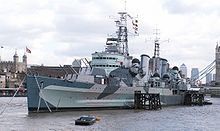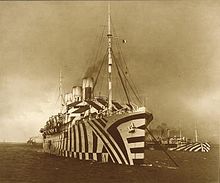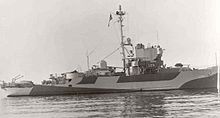- Dazzle camouflage
-
"Dazzle Ships" redirects here. For the Orchestral Manoeuvres in the Dark album, see Dazzle Ships (album).
 HMS Argus displaying a coat of dazzle camouflage in 1918
HMS Argus displaying a coat of dazzle camouflage in 1918
 HMS Belfast repainted in WWII dazzle camouflage in 1999
HMS Belfast repainted in WWII dazzle camouflage in 1999
 The troopship HMS Empress of Russia, painted with dazzle camouflage in World War I
The troopship HMS Empress of Russia, painted with dazzle camouflage in World War I The RMS Mauretania also served as a troopship with dazzle paint
The RMS Mauretania also served as a troopship with dazzle paint
 Painting of Dazzle-ships in Drydock at Liverpool, by Edward Wadsworth, 1919
Painting of Dazzle-ships in Drydock at Liverpool, by Edward Wadsworth, 1919
Dazzle camouflage, also known as Razzle Dazzle or Dazzle painting, was a camouflage paint scheme used on ships, extensively during World War I and to a lesser extent in World War II. Credited to artist Norman Wilkinson, it consisted of a complex pattern of geometric shapes in contrasting colours, interrupting and intersecting each other.
Contents
Mechanism
At first glance Dazzle seems unlikely camouflage, drawing attention to the ship rather than hiding it, but this technique was developed after the Allied Navies were unable to develop effective means to disguise ships in all weathers.
Dazzle did not conceal the ship but made it difficult for the enemy to estimate its type, size, speed and heading. The idea was to disrupt the visual rangefinders used for naval artillery. Its purpose was confusion rather than concealment.[1] An observer would find it difficult to know exactly whether the stern or the bow is in view; and it would be equally difficult to estimate whether the observed vessel is moving towards or away from the observer's position.[2]
 USS Charles S. Sperry (DD-697) shown here in dazzle camouflage, June 1944.
USS Charles S. Sperry (DD-697) shown here in dazzle camouflage, June 1944.
Rangefinders were based on the co-incidence principle with an optical mechanism, operated by a human to compute the range. The operator adjusted the mechanism until two half-images of the target lined up in a complete picture. Dazzle was intended to make that hard because clashing patterns looked abnormal even when the two halves were aligned. This became more important when submarine periscopes included similar rangefinders. As an additional feature, the dazzle pattern usually included a false bow wave to make estimation of the ship's speed difficult.
The demonstrable effectiveness of the bold Dazzle camouflage was accepted by the Admiralty, even without practical visual assessment protocols for improving performance by modifying designs and colours.[3] The Dazzle camouflage strategy was adopted by other navies. This led to more scientific studies of colour options which might enhance camouflage effectiveness. Broken colour systems which present units so small as to be invisible as such at the distances considered are neither advantageous nor detrimental to the dazzle effect; the visibility of the camouflaged vessel at a given distance would depend entirely upon such scientifically measurable factors as the mean effective reflection factor, hue and saturation of the surface when considered at various distances.[4]
In the UK, the British Army inaugurated its Camouflage Section at the end of 1916; while at sea, the marine painter Norman Wilkinson invented the concept of dazzle painting as a way of using stripes and disrupted lines to confuse the enemy about the speed and dimensions of a ship.[5] Wilkinson, then a lieutenant commander on Royal Navy patrol duty, implemented the precursor of "dazzle" on
A building in the Razzle Dazzle style in Los Angeles
- ^ "Camouflage , Norman Wilkinson", Letters, The Times, Apr 04, 1939
- ^ a b Glover, Michael. "Now you see it... Now you don't," The Times. March 10, 2007.
- ^ Williams, David. (2001). Naval Camouflage 1914-1945, p. 35.
- ^ Williams, p. 40.
- ^ Fisher, Mark. "Secret history: how surrealism can win a war," The Times. January 8, 2006.
- ^ Paulk, Ann Bronwyn. "False Colors: Art, Design, and Modern Camouflage (review)," Modernism/modernity. 10:2, 402–404 (April 2003). DOI: 10.1353/mod.2003.0035
- ^ http://www.shipcamouflage.com/measures.htm US Navy WWII Camouflage Measures
- ^ http://www.steelnavy.com/rnchips.htm
- ^ http://smmlonline.com/articles/kriegsmarinecamo/kreigsmarine.html
- ^ Latimer, Jon (2003). Deception in War: The Art of the Bluff, the Value of Deceit, and the Most Thrilling Episodes of Cunning in Military History, from the Trojan Horse to the Gulf War.[1] (abstract)
- ^ Campbell-Johnson, Rachel. "Camouflage at IWM," The Times. March 21, 2007.
- ^ http://www.engadget.com/2011/03/15/student-thwarts-face-detection-software-with-cv-dazzle-makeup/
- ^ http://www.todayandtomorrow.net/2010/03/31/computer-vision-dazzle-makeup/
- Behrens, Roy R. (2003). False Colors: Art, Design, and Modern Camouflage. Dysart, Iowa :Bobolink Books. 10-ISBN 0-9713244-0-9; 13-ISBN 978-0-9713244-0-4 OCLC 48953911
- Behrens, Roy R. (2009a). CAMOUPEDIA: A Compendium of Research on Art, Architecture and Camouflage. Bobolink Books. ISBN 978-0-9713244-6-6.
- Behrens, Roy R. (2009b), "Camouflage" in E. Bruce Goldstein, ed., Encyclopedia of Perception. Sage Publications, pp. 233–236. ISBN 978-1-4129-4081-8.
- Elliot, Peter. (1974). American Destroyer Escorts of WW2. London: Almark Publishing. 10-ISBN 0-85524-160-8; 13_ISBN 978-0-85524-160-5; [ OCLC 1254543]
- Latimer, Jon. (2003). Deception in War: The Art of the Bluff, the Value of Deceit, and the Most Thrilling Episodes of Cunning in Military History, from the Trojan Horse to the Gulf War. New York: Penguin USA. 10-ISBN 1-58567-381-1; 13-ISBN 978-1-58567-381-0
- Williams, David. (2001. Naval camouflage, 1914-1945 : a complete visual reference. Annapolis, Maryland: Naval Institute Press. 10-ISBN 1-55750-496-2; 13-ISBN 978-1-55750-496-8 OCLC 48895030
- Artists and Other Contributors to Camouflage in the 20th Century
- Newly Discovered Dazzle Plans at Rhode Island School of Design
- The Development of Naval Camouflage 1914–1945
- Camoupedia: Dazzle Camouflage
- Razzle Dazzle Camouflage
- Guilty: yacht designed by Jeff Koons in Dazzle style, launched 2008
- "She's All Dressed Up For Peace," Popular Science (February 1919), p. 55.
All British patterns were different, first tested on small wooden models viewed through a periscope in a studio. Most of the model designs were painted by women from London's Royal Academy of Arts. A foreman then scaled up their designs for the real thing. Painters, however, were not alone in the project. Creative people including sculptors, abstract artists[clarification needed], and set designers designed camouflage.[6]
The Vorticist artist Edward Wadsworth supervised the camouflage of over two thousand warships, and his post-war canvases celebrated his dazzling ships.
World War I
Dazzle's effectiveness is not certain. The British Admiralty concluded it had no effect on submarine attacks, but boosted crew morale. It also increased the morale of people not involved in fighting; hundreds of wonderfully coloured ships in dock was nothing ever seen before or since.
In a 1919 lecture, Norman Wilkinson explained:
The primary object of this scheme was not so much to cause the enemy to miss his shot when actually in firing position, but to mislead him, when the ship was first sighted, as to the correct position to take up. [Dazzle was a] method to produce an effect by paint in such a way that all accepted forms of a ship are broken up by masses of strongly contrasted colour, consequently making it a matter of difficulty for a submarine to decide on the exact course of the vessel to be attacked... The colours mostly in use were black, white, blue and green... When making a design for a vessel, vertical lines were largely avoided. Sloping lines, curves and stripes are by far the best and give greater distortion.
During both World Wars, former ocean liners owned by British steamship companies like Cunard Line were re-commissioned as an integral part of the British war fleet. These auxiliary vessels were re-fitted with armament and re-painted in the same manner as other fleet ships. For example, the Canadian Pacific Steamships RMS Empress of Russia and White Star Line RMS Olympic (sister ship of the ill-fated RMS Titanic and HMHS Britannic), former passenger liners, were given the "dazzle" treatment when used as troopships.
World War II
American naval leadership thought dazzle effective and, in 1918, the U.S. Navy adopted it as one of several techniques.
However effective the scheme was in World War I, dazzle camouflage became less useful as rangefinders and especially aircraft became more advanced, and, by the time it was put to use again in World War II, radar further reduced its effectiveness. However, it may still have confounded enemy submarines. The US Navy implemented a camouflage painting program in World War II, and applied it to many ship classes, from patrol craft and auxiliaries to battleships and some Essex-class aircraft carriers. The designs (known as Measures, each identified with a number) were not arbitrary, but were standardised in a process which involved a planning stage, then a review, and then fleet-wide implementation (see more at: Ship camouflage).
Not all USN measures involved dazzle patterns; some were simple or even totally unsophisticated, such as a false bow wave on traditional Haze Grey, or Deck Blue replacing grey over part or all of the ship (the latter being utilized to counter the kamikaze threat).[7] Dazzle continued to be used until the end of World War II.
In the British Royal Navy, dazzle paint schemes reappeared in January 1940; these were unofficial and competitions were often held between ships for the best camouflage patterns. The RN Camouflage Department came up with a scheme devised by Peter Scott, a wildlife artist, which were developed into the Western Approaches Schemes. In 1942 the Admiralty Intermediate Disruptive Pattern came into use, followed in 1944 by the Admiralty Standard Schemes.[8]
The German Navy first used camouflage in the 1940 Norwegian campaign. A wide range of patterns were authorised, but most commonly black and white diagonal stripes were used. Most patterns were designed to hide ships in harbour or near the coast; they were often painted over with plain grey when operating in the Atlantic.[9]
Art history
Winston Churchill considered deception in war to be an indispensable "element of léger de main, an original and sinister touch, which leaves the enemy puzzled as well as beaten."[10]
In 2007, the art of concealment was featured as the theme for a show at the Imperial War Museum. The evolution of Dazzle was re-examined in this context. Picasso is reported to have taken credit for the modern camouflage experiments which seemed to him a quintessentially Cubist technique.[11] He is reported to have drawn the connection in a conversation with Gertrude Stein shortly after he first saw a painted cannon trundling through the streets of Paris.[2]
In 2008, the Fleet Library at the Rhode Island School of Design announced the rediscovery in its collection of 455 lithographic printed plans for the camouflage of US merchant ships during World War I. These documents were donated to the RISD library in 1919 by one of the school’s alumni, designer Maurice L. Freeman, who had been a camouflage artist for the U.S. Shipping Board in Jacksonville, Florida. Portions of the collection were publicly shown at the RISD library for the first time from January 26 through March 29, 2009, in an exhibition titled "Bedazzled."
Modern use
In modern times, dazzle camouflage is seldom used. In Austria, speed traps have been camouflaged with dazzle to confuse drivers on the direction the radar is pointing. Many car prototypes also wear dazzle camouflage during testing to hide the "curves" of the vehicle before the manufacturer is ready to show it to the public.
Museum ships HMS Belfast, moored in the River Thames in London, England, HMCS Sackville, moored in Halifax Harbour in Halifax, Nova Scotia, Canada, and USS North Carolina, moored in Wilmington, North Carolina, United States, are painted in the dazzle camouflage they used during the Second World War.
Dazzle makeup, or "CV Dazzle" (computer vision dazzle), to hamper automatic computer detection and recognition of faces, has been mooted as a response to mass surveillance.[12][13]




